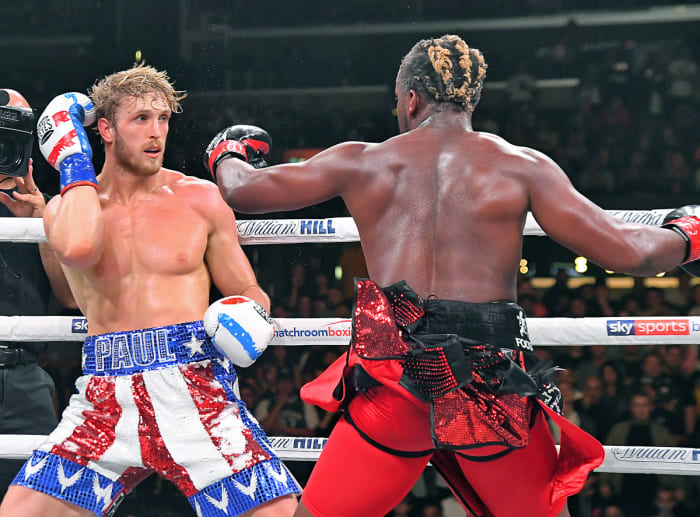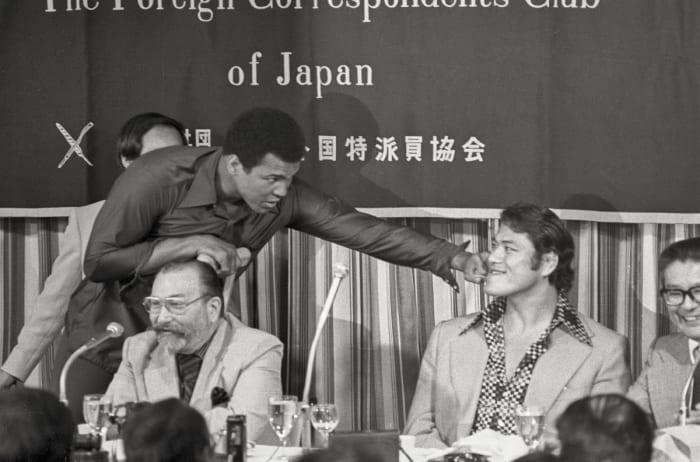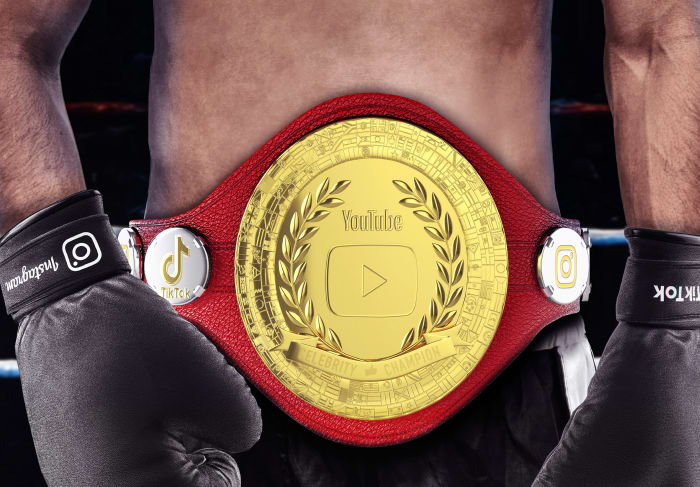Stream Warriors
Here's a thought exercise. Imagine you’re a boxing ring announcer. Then consider the strain it would entail to keep the straight face required for legitimacy, as you say words to this effect:
“In the corner to my right: He is 43 years old, weighs in at 147 pounds and brings an unblemished record of 50–0 . . .”
“And in the corner to my left: He is 25 years of age, weighs 199 pounds and comes in with a record of 0–1 . . .”
Such will be the task confronting some off-brand Michael Buffer soon, when Floyd Mayweather Jr. and Logan Paul finally flounce into the ring for what will be, by any measure—hype, buys, traffic—one of the biggest fights of 2021. Originally scheduled for Feb. 20, the fight has been postponed because of, in the words of a source quoted by TMZ, “COVID and other things.” But at some date in the near future, there will likely be a fight. There’s too much money to be made.
Mayweather, boxing’s unsurpassed fighter over the last quarter-century, now episodically retired, will next face an opponent who is 50 pounds heavier, almost two decades younger and has yet to win a professional fight. And this pay-per-view event—put on by celebrity custom video platform Fanmio—will mark one of those lamentably rare nights when boxing will both penetrate the defenses of the mainstream and connect with a younger audience.
The Mayweather-Paul tale of the tape—comically ill-matched as it might be—is also the tale of the entire sport. For decades now, boxing has been a study in dysfunction. Promotional politics have forestalled the obvious, anticipated fights. The pay-per-view model enriched a select few stars but pulled the sport off network and cable TV (remember cable TV?) and caused it to fade further into the margins. Boxing didn’t alter its planning when mixed martial arts, a more centralized and slickly produced combat sport, moved in and siphoned its audience.
Nostalgic for Joe Louis and Rocky Marciano and Howard Cosell interviewing Muhammad Ali and Mike Tyson, a legion of fans and observers (SPORTS ILLUSTRATED included) repeatedly posed the existential question: What will save boxing? For all the possibilities bandied about—The Contender, Saturday-night fights on NBC, more weight classes, fewer weight classes, an American heavyweight champ—who foresaw that boxing’s revival might come from a video-sharing platform?

Logan Paul and KSI had no pro experience when they met in November 2019.
JAYNE KAMIN-ONCEA/GETTY IMAGES
But here we are. Boxing, the most throwback of sports, has been thoroughly transformed, if not outright resurrected, by YouTube. As Tyson himself recently put it, “Boxing was pretty much a dying sport. UFC was kicking our butts, and now we got these YouTubers boxing with 25 million views. Boxing’s coming back, thanks to these YouTube boxers.”
A fighter’s win-loss record is no longer the best representation of their importance to promoters; it’s the size of their online following. Terence Crawford, a 33-year-old welterweight from Omaha, might be the world’s best pound-for-pound fighter. But he has no real YouTube profile and a relatively modest 655,000 Instagram followers. If Paul can bring 22.8 million subscribers and 19 million Instagram followers—and can convert even a small fraction of his social media following to $59.99 pay-per-view buys—it’s clear who has more value in the current boxing economy.
“It’s a truly difficult and special sport, and I feel for these [boxers] who’ve come up the hard way, seeing other guys jump the line and get the fights and get the money,” says Teddy Atlas, the veteran trainer and host of the boxing podcast The Fight. “Then again, it’s the marketplace. To get big fights now, you don’t necessarily have to be skilled and credentialed.”
Paul, unmistakably, is neither. In his first and only pro fight, he lost a split decision to the British rapper, comedian and gaming personality KSI. But thanks to their respective YouTube followings (KSI also has more than 22 million subscribers on the platform), the fight drew more than one million pay-per-view buys, to say nothing of the illegal streams on Twitch.
Logan Paul is also not to be confused with Jake Paul. That’s his younger brother (2–0), also a YouTube provocateur who occasionally moonlights as a boxer. Jake will next fight Ben Askren, an MMA fighter, on April 17. It’s a logical next step after Jake starched former NBA slam dunk champion Nate Robinson on the undercard of November’s Tyson–Roy Jones Jr. eight-round exhibition.
That was two weeks after Crawford beat Kell Brook to defend his welterweight belt. Tyson-Jones sold more than 1.6 million PPV buys, at $49.49 apiece. That was roughly the same audience that saw Crawford-Brook on ESPN. For free.
The concept of the sideshow is not, of course, new to boxing. In 1976, Ali went to Tokyo to fight pro wrestling champion Antonio Inoki for the so-called “martial arts championship of the world.” In the 1990s, Eric Esch, aka Butterbean, the oversize “King of the Four Rounders,” barnstormed the country and gained more acclaim than far more skilled colleagues.
But only recently has the sideshow become the main event; the celebrity boxing market has become the market. There is the right hand. There is the left. And there is the invisible hand. The same market forces enriching YouTube arrivistes also apply to former champs. Fertilized by social media, there are projections that a third fight between Tyson, now 54, and Evander Holyfield, 58, could gross $200 million.
No one has benefited from this new, disrupted boxing economy more than Mayweather. Never mind his boxing skills; he has a singular talent for getting maximum paydays for minimum effort. In the summer of 2017, he fought Conor McGregor, the mixed martial arts star. Mayweather was guaranteed a $100 million floor for the fight but, once the last of the 4.3 million pay-per-view buys were tallied, he reportedly took home $280 million. That Mayweather won by way of a 10th-round TKO was almost beside the point.

BUTTERFLY EFFECT Ali’s 1976 battle with Inoki has been credited with giving birth to the concept of MMA.
KAKU KURITA/GAMMA-RAPHO/GETTY IMAGES
For the upcoming fight against Paul, Mayweather reportedly will receive $5 million up front and then 50% of the pay-per-view sales. (Paul will reportedly get a $200,000 guarantee and 5% of the PPV haul, which will still make for a seven-figure payout.) Says UFC impresario Dana White, himself no stranger to pay-per-view lucre, “If you’re Floyd and you can make $20 million or even $10 million and not worry about training or getting touched, why not?”
Just as styles make fights, boxing, for all its old-school trappings, is singularly well-suited for new media, social media and streaming platforms. For one, it’s the ideal platform for the prefight, hype-generating callouts. While a “flamboyant” fighter once wore a gaudy silk robe into the ring, or served up self-aggrandizing sound bites or conferred on himself an outrageous nickname, he now stars in his own viral videos, and, say, covers himself in peanut butter and ventures to the local dog park, as Logan Paul did last year.
The Paul brothers have turned this into performance art. Trying to gin up interest in a fight, Jake Paul made videos pelting McGregor’s entourage with water balloons and renting a plane to brandish the message CONOR MCGREGOR IS SCARED OF JAKE PAUL that generated millions of views.
After some broadsides from Logan Paul, Mayweather tweeted: “These YouTube girls better find some Barbie dolls to play with cause I’m not the one for the kid games.” Within a day, the tweet had more than 50,000 likes. That’s a lot more effective for selling a fight than some choreographed press conference.
Then there is the actual event. No one wants to watch some YouTube yutz play 18 holes against Tiger Woods or sprint against Usain Bolt. But there is, of course, something visceral, evolutionary even, about fighting. Paying $60 to open a browser and watch Paul get pummeled, and possibly bloodied, by Mayweather? To millions, sure, that sounds like a fair exchange.
As for the inevitable question—Is it good for boxing?—we know how this plays out. The purists cringe and complain that the sport’s credibility is eroded when Terence Crawford receives a fraction of the fanfare of the Paul brothers. (Strangely, Jake Paul falls into this camp. Asked to predict the outcome of his brother’s fight against Mayweather he said, “‘My brother’s f-----. It’s bad for the sport.”)
The other side echoes Tyson. Hey, if the YouTube stars bring in a new audience willing to watch clips of boxing—and, better still, willing to devote disposable income to pay-per-views—boxing wins.
The real question, given this new reality: Who benefits? The answer is a boxer who marries form and function, someone with legitimate skills who can also bring the audience through their social media following. Take, for instance, 22-year-old Ryan Garcia (SI, Fall 2020), currently Ring magazine’s No. 3–ranked lightweight. Nearly a million YouTube subscribers have watched @kingryang cut weight and spar with Canelo Álvarez and throw an ax. Last year the YouTube videos of his “Body Shot Challenge”—conceit: He unleashes body shots on volunteers, some of whom even come armored with chest protectors and full padding—made for oddly irresistible viewing. (In one segment, he breaks a rib of, yes, Jake Paul.)
With a measure of respect, not trolling, Garcia has requested a fight against Manny Pacquiao, who, at 42, was reportedly in talks for a big-money crossover fight against McGregor. Garcia’s callout on Instagram grabbed two million likes and Pacquiao’s attention.
Meanwhile, as the inevitable buildup for a Mayweather-Paul fight swells, here’s a refrain you’ll hear again and again, especially from the boxing purists: Floyd has no business being in the ring with that guy.
On the contrary, he has plenty of business.
